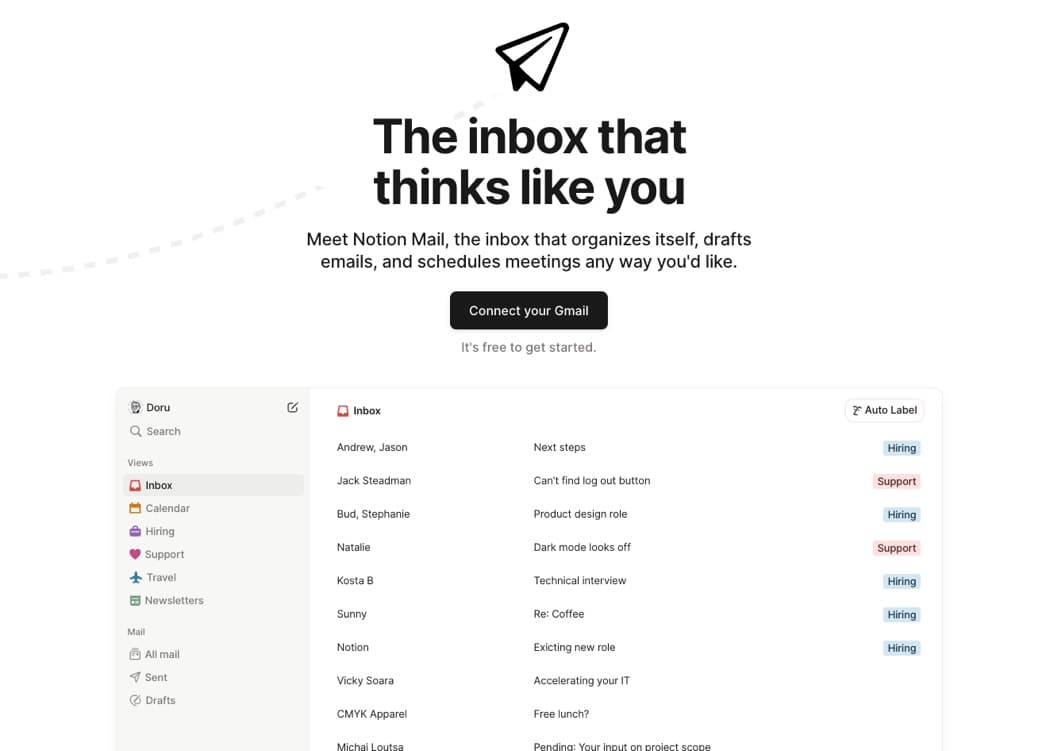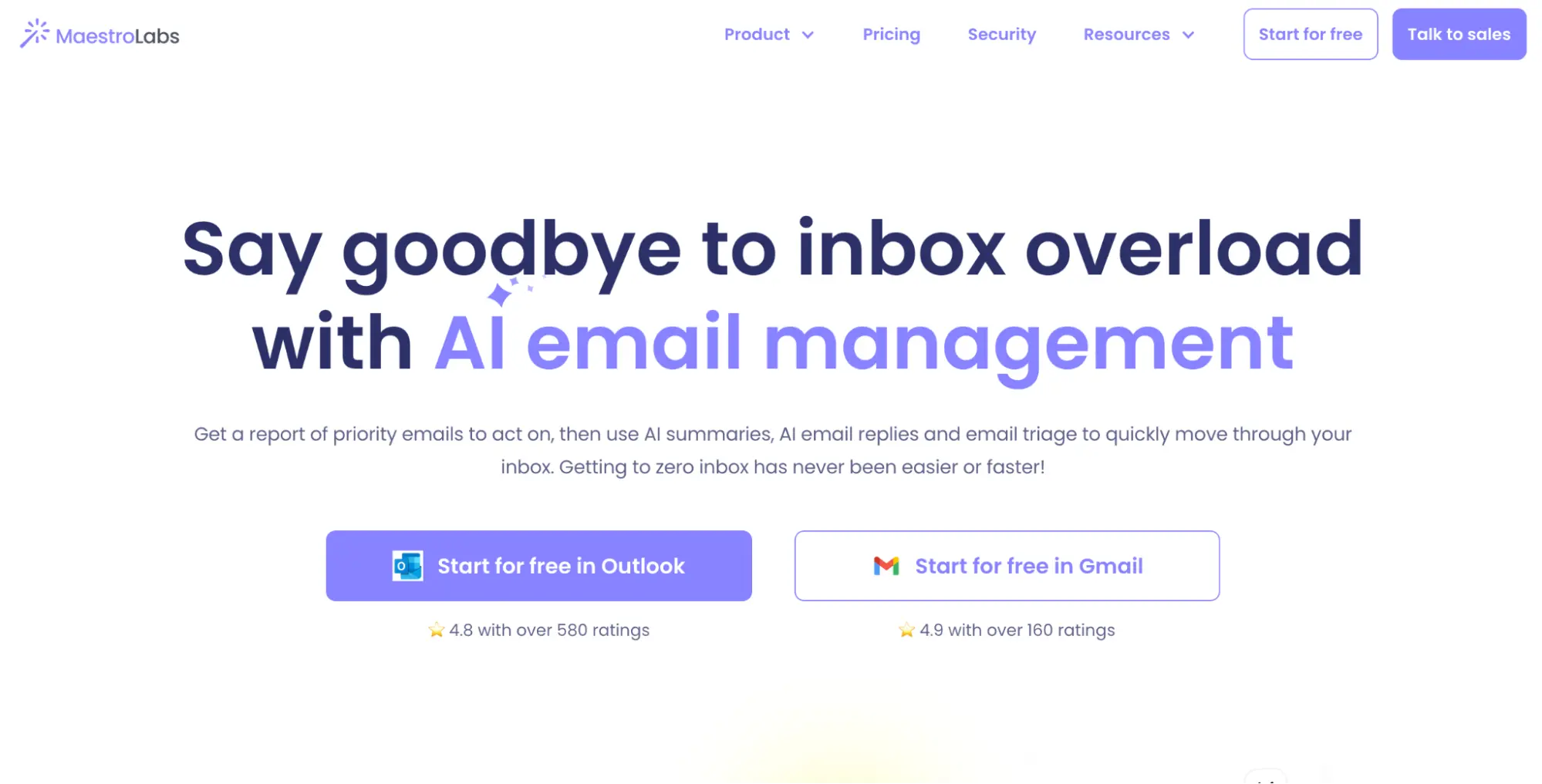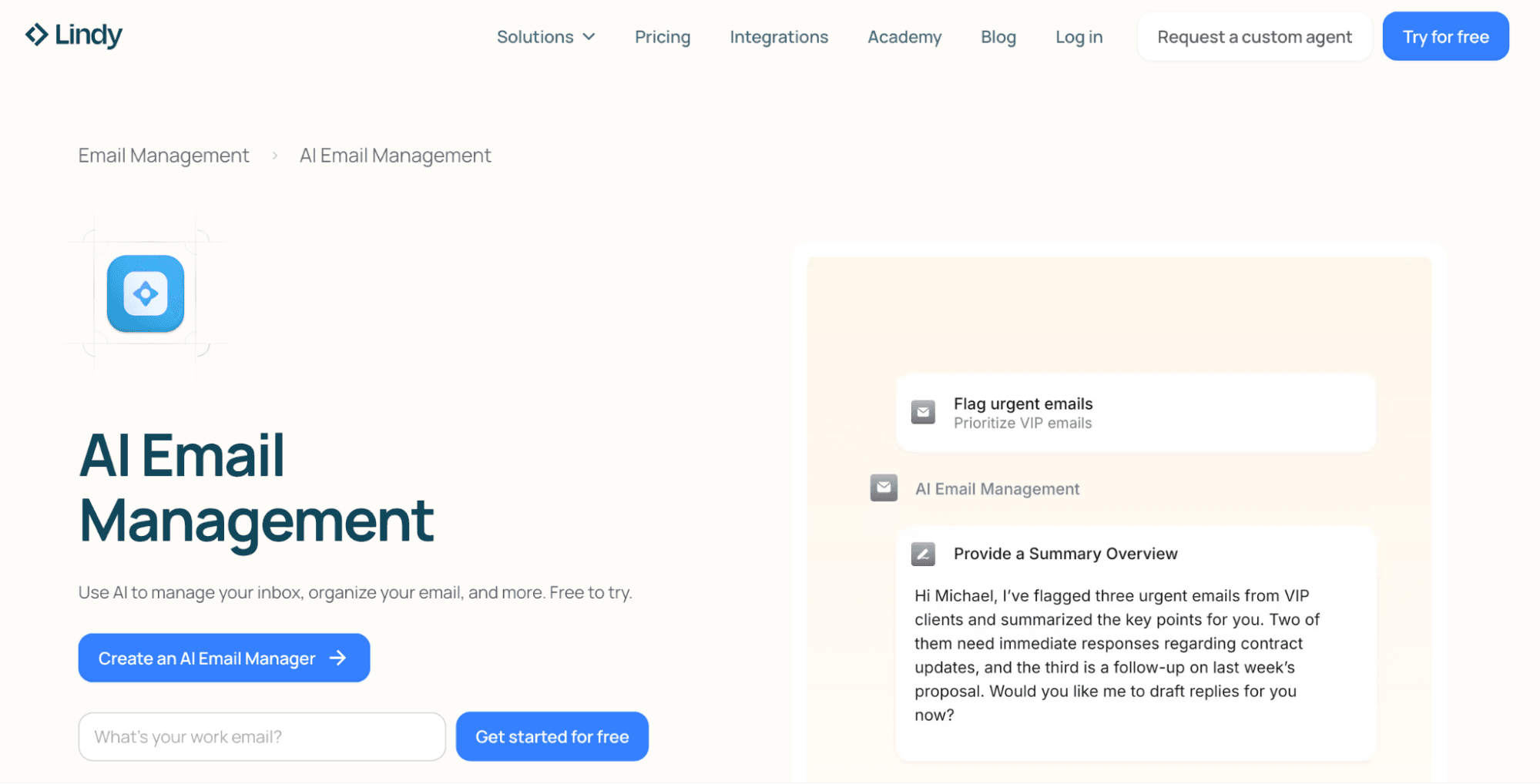If you’re drowning in emails every day, you’re not alone. What once was a simple communication tool has evolved into a nonstop stream of messages, tasks, and information.
Does this constant inflow of personal and professional communication makes it difficult to stay organized, hit deadlines, and focus on the essential details? Yes.
But email is changing. Thanks to AI, modern email services are becoming smarter and more proactive. The latest tools are helping users transform their inboxes from sources of stress into streamlined productivity hubs.
This guide is your roadmap to mastering AI email management. Inside, we’ll cover:
How AI-powered email management works
The key benefits of using it
How to organize your inbox with smart tools
Top AI email management tools to finally take control of your inbox
What is AI email management?
Email is a time sink for many professionals, consuming between five and 15.5 hours every week, depending on the role and industry.
Instead of spending these many hours managing and attending to your email, with AI email management, you can use advanced automation features to optimize your email-related busywork and free up your time.
AI email management software helps streamline all kinds of email activities, including sorting and filtering your inbox, writing new emails, generating responses, and sending automated follow-up emails. It functions as a handy virtual assistant, conducting email triage on your behalf based on simple prompts so you can focus on your “real” work.
Many AI email management software functions as email clients, integrating with major email providers like Gmail and Microsoft Outlook to help you improve your existing inbox without starting from scratch.
Types of AI email management tools
There are different types of AI tools for managing emails, and they can be categorized according to their primary functions. Many offer similar functionalities with varying scopes and focus areas.
The most common types include:
AI-powered email clients
AI-powered assistants
AI email writing and scheduling tools
1. AI-powered email clients
Smart AI-powered email clients are designed as an all-encompassing email solution. They function like traditional email clients but with built-in AI tools as part of their core features. Many can intelligently auto-sort and prioritize your emails and help you build more streamlined workflows.
These email clients aim to improve and simplify your email experience, reducing the time and effort spent managing your entire inbox. Notion Mail is a good example of this type of user-friendly AI email management tool.
2. AI-powered assistants
Built-in AI assistants work with your existing email accounts, such as Gmail and Outlook. Some may offer features you’ll find in AI-powered email clients, but they’re primarily focused on improving your experience in your existing email setup.
They don’t require you to switch to an entirely new email system to enjoy their benefits. An example is Gmail’s Smart Compose or Smart Reply features.
3. AI email writing and scheduling tools
AI-driven email writing and scheduling tools focus primarily on applying AI to specific aspects of email management, such as writing or scheduling meetings.
For instance, an add-on tool like Grammarly will help you fine-tune your emails by suggesting grammar improvements. Similarly, Gather AI eliminates the need for manual meeting scheduling, reducing email back-and-forth.
These tools function well for users who don’t need an all-in-one productivity environment. If you’re in an ecosystem like Notion, you can access such intelligent writing and scheduling tools independently.
The benefits of using AI for efficient email management
There are significant advantages to using AI for email management. Surveys have found that companies that use AI-powered communication tools for work notice a 20–25% boost in productivity.
Here’s how AI is helpful for email management:
Improved productivity: Automates time-consuming email tasks, such as sorting and labeling emails, scheduling meetings, or drafting repeat responses, freeing up your time for more strategic work.
Reduced overwhelm: Filters out irrelevant and low-priority emails, such as spam or promotional emails, to minimize your attention drain.
Efficient organization: Auto-sorts and categorizes your emails based on tailored criteria so your inbox is tidy and search-friendly.
Faster response times: Suggests relevant replies to common inquiries, drafts new emails, or automatically sends follow-up messages in your absence, ensuring low-effort yet rich communication.
Better information processing: Grasping information from lengthy email threads or complex messages becomes effortless thanks to brief summaries. You don’t have to read every work to grab context during triage.
Clearly, AI reduces the need for manual effort in almost every aspect of email management, making it a game-changer for users looking to gain better control of their inbox without being overly hands-on.
Using AI to manage emails: Debunking common myths
Even though AI has great potential for helping users enhance inbox triage efficiency, some misconceptions still surround its use in managing email.
Here’s a closer look at those myths and misconceptions:
AI takes away control
AI makes emails impersonal
AI is too complex for non-tech-savvy people
Myth: AI takes away control
Some users worry that AI will take over their email management entirely, shutting them out with no control over inbox activities. This is not true—AI-powered tools are designed to aid human efforts within defined limits.
You can set the parameters yourself, training the AI to take the same actions you typically would. If you notice any inconsistencies, you can fine-tune or override the AI’s actions and do it yourself. AI email assistants are merely tools that speed up your workflow.
Myth: AI makes emails impersonal
Generative AI has been around for several years, and while the tools once were rule-based and rigid, they have since evolved. Many users worry that AI-generated emails will sound robotic and impersonal, like chatbots and AI tools from the past.
The truth is that modern-day AI can be trained to mimic your tone and writing style. Your AI-assisted communications mimic your voice to remain personal and relatable.
Myth: AI is too complex for non-tech-savvy people
People often perceive AI as too difficult to learn, either due to a lack of technical skills or because the concept is relatively new to them. However, many AI email management tools feature user-friendly interfaces and intuitive designs, making them accessible to both beginners and professionals.
Most of the tools work using simple language prompts, allowing you to instruct them just as you would when speaking to a personal assistant.
How to use AI to manage email
AI comes in handy when managing emails in more ways than one, especially for reducing the amount of time and manual effort needed to stay on top of your inbox. Here are five use cases to manage email with AI support:
Sort your inbox quicker and more accurately
Write emails faster and respond with ease
Prioritize what’s important with the right inbox views
Grasp the context of messages quickly with email summaries
Automate meeting scheduling
1. Sort your inbox quicker and more accurately
Many professionals receive a large volume of emails every day, making it easy for urgent or essential communications to get lost in the noise. Instead of manually setting up complex filter rules to sort your inbox, you can use AI to automatically categorize incoming emails based on their sender, content, or past behavior.
You can use simple AI prompts to tell your email provider which labels to apply to an email so your important messages get filed under the correct label. For example, you may set your AI to automatically label messages from your manager’s email address as ‘Urgent’ or instruct it to sort newsletters with certain keywords into a ‘Promotions’ tab.
Leveraging AI for inbox management reduces the complexity and rigidity of filter rules, eliminates the need for micromanaging your inbox, and reduces the chances of misclassifying emails.
2. Write emails faster and respond with ease
One of the main challenges people face when managing their inbox is knowing how to respond to an email with the right tone and context. AI can significantly streamline this process, saving time and ensuring effective communication.
It can analyze the context of your emails to suggest words, phrases, or even complete replies as you type, helping you write faster and more efficiently.
Some AI tools can help you draft an email from scratch if you provide details on the content and the writing tone and style to follow. If the AI misses the mark, you can give further instructions, and it’ll fine-tune the draft until you’re satisfied.
A simple prompt like “Help me draft a response to this email indicating my interest in the product” can generate a full reply from scratch in seconds.
3. Prioritize what’s important with the right inbox views
Traditional email tools offer limited customization when organizing your inbox. For example, a provider like Gmail allows you to view your emails in split views or sort them by order of importance or starred status.
AI-powered email tools offer more customization options than this. They enable you to tailor your inbox with highly curated views based on your priorities and workflows. You get focused inboxes where you only see what matters when you need to. These tools can also learn your workflow and filter out the less relevant messages.
For example, an AI email assistant can create an ‘Upcoming Meetings’ view, collating high-priority emails based on the meeting dates extracted from those messages.
4. Grasp the context of messages quickly with email summaries
When organizing your inbox, it often takes time to review lengthy emails to understand the point being made so you can respond accordingly. AI email summarization features can help you save time by analyzing email threads and providing key takeaways from the email content.
You can quickly get up to speed with the information in the email so that you can write or generate a context-based, relevant response to the conversation. This allows you to work through your inbox faster, reducing clutter and unread or unattended messages.
5. Automate meeting scheduling
AI scheduling assistants simplify the typically tedious meeting scheduling process by allowing recipients to schedule meetings directly in their inboxes. Some of these tools can identify your availability based on your calendar schedule and suggest times intuitively.
Other tools coordinate the time zones of the parties involved, only offering a time that works for both parties. Once a meeting time is agreed on, AI email management scheduling tools can automatically create and send calendar invites to all parties, directly adding the event to all their calendars.
This process eliminates the tiring email ping-pong that generally comes with scheduling meetings.
Top 5 AI email management tools
With the growing number of AI email management tools, the burden of choice gets heavier. We’ve reviewed the five best AI-powered email tools that provide comprehensive email assistance within an integrated approach. They are:
Notion Mail
MailMaestro
LindyAI
Mailbutler
SaneBox
1. Notion Mail

Notion Mail is an AI-first email client that’s built to help you manage your inbox more efficiently by automating the tedious aspects of traditional email management.
Notion Mail really shines with its AI-driven functions, such as AI autopilot. This feature leverages AI to auto-sort and label your emails with simple prompts (you don’t have to manually create complex filters). Autopilot can also help you extract key information from emails so you can find what you need faster.
With AI-powered email summarization, you no longer have to wade through long email threads to absorb information. Notion Mail uses AI to deliver concise summaries so that you can take prompt action. It also offers an intelligent AI writing assistant that suggests tailored quick replies or even generates full email drafts, making it easier to craft clear, relevant responses in minutes.
Notion Mail takes meeting scheduling to the next level, allowing you to insert scheduling buttons like Calendly directly into emails so that recipients can book a time at their convenience. You can also use the convenient /schedule command to automate intelligent meeting scheduling.
Notion Mail offers other valuable email management tools like:
Customizable views that let you create a tailored inbox view using AI categorization
Keyboard shortcuts to speed up email-related actions like Mark as Read or Archive
Automated follow-up emails that allow you to keep in touch with correspondents in your absence
Pros | Cons |
AI-powered automation Prompt-based inbox organization Highly customizable inbox views AI writing assistance |
2. MailMaestro

MailMaestro offers all-around support, functioning as an AI email assistant that helps you keep your inbox under control. It assists with email summarization, reply generation, and even automation of repeat tasks, allowing you to process emails faster and save time.
In addition to the above, MailMaestro leverages AI to offer you more features like:
Smart sorting: The tool automatically sorts your emails based on importance, ensuring your inbox stays organized and crucial messages aren’t buried. It uses priority inbox reports to give you a quick overview of the most important messages.
Meeting scheduling: Using AI, MailMaestro auto-detects meeting invites and lets you respond in one click, suggesting optimal meeting times based on your calendar.
AI meeting notes: The tool offers an AI note taker for Microsoft Teams that provides a clear summary and action points of your meetings.
One drawback to using MailMaestro for email drafting is that AI suggestions sometimes need tweaking to match the right tone, but this can be done easily. The tool can also become slow when drafting longer emails.
Pros | Cons |
Saves time with summarization Smart sorting Supports meeting scheduling Speeds up response times | Suggested replies need some editing Writing assistant sometimes gets slow Limited training options |
3. LindyAI

Lindy is an AI agent builder that helps you create your own personalized AI assistant. It automates your workflows and repetitive tasks, including email management. The tool integrates into all the platforms you work on, including Gmail, to help you save hours every week.
Its AI-powered features can assist with:
Intelligent inbox organization: Automatically organizes unread emails to help you identify important ones
Reply reminders and AI-generated replies: Proactively remind you to respond to important emails and draft replies for you to save time and effort
Trigger-based automation: Allows you to set up triggers that automate actions based on specific email events, so you’re up to date on your communications even in your absence
While Lindy is designed for ease of use, customizing its rule-based trigger systems to fit your needs may require a learning curve.
Pros | Cons |
Auto-prioritizes key emails Summarizes long email threads Automates email replies and reminds you to reply | May present a learning curve when customizing triggers Bots are not always accurate |
4. Mailbutler

Mailbutler is an email extension that helps boost productivity by integrating AI features directly into major email providers. Its Smart Assistant offers several features that enhance email management, such as Smart Compose, which drafts emails when you provide a few keywords.
There’s also the Smart Respond, Smart Summarize, and Smart Improve feature, which suggests improvements to spelling and grammar in your email. One of the features that makes Mailbutler shine is its data extraction feature, which finds and extracts contact information from email signatures, giving you a complete overview of who you’re corresponding with.
It also processes your email content to help you find your tasks, and then collates them in a to-do list that’s easily accessible. One drawback of Mailbutler is that it’s not always reliable, especially when integrated with Apple Mail. The scheduling feature can also be glitchy at times.
Pros | Cons |
Smart Assistant features Integrable task management tools Contact information extraction | Glitchy scheduling tools Unreliable integration with some OS Not super intuitive |
5. SaneBox

SaneBox uses AI algorithms to analyze your emails and email habits, prioritize crucial messages, and compile less urgent ones into separate folders. This allows you to focus on emails and tasks that need your attention.
Its top email management features include:
SaneLater: This core feature uses AI to move non-urgent emails out of your main inbox into a folder to be accessed later, eliminating distractions from your primary workflow.
SanePriority: It identifies crucial emails and ensures they never get misclassified in the wrong folder. Based on your inbox habits, it learns which senders are essential to you and prioritizes them.
SaneBox also offers SaneBlackHole for blocked emails, SaneNews for newsletters, and SaneReminders that prompt you to follow up with an email. The tool helps you keep out emails from unwanted senders with quick unsubscribe options.
However, this feature is not always seamless—some users have found that emails still come in from unsubscribed senders, requiring you to manually unsubscribe from your inbox.
Pros | Cons |
Automatically prioritizes emails Blocks spam email Offers email reminders Learns and adapts to your workflow | Loses accuracy over time Inconsistent unsubscribing New senders may get misclassified |
The verdict: What’s the best AI tool for email management?
Each AI email management tool brings unique strengths—from advanced scheduling to smart filtering and writing assistance.
However, the majority of users, from productivity enthusiasts to business owners, derive the greatest benefits from an integrated and proactive approach to managing their inbox. Among the platforms reviewed, Notion Mail stands out by delivering all of that.
Unlike the other tools, it provides a comprehensive AI-powered ecosystem that learns your preferences, automates complex workflows, offers deep customization, and integrates seamlessly with your broader productivity setup. Together, these capabilities make Notion Mail the most compelling choice for mastering AI-driven email management.
Sign up for Notion Mail
Getting started with Notion Mail is pretty straightforward. All you need to do is visit the signup page and connect your Gmail or Google account.
Notion Mail is free to use and provides access to powerful AI automation features and other workspace tools for writing and scheduling. For even more advanced AI capabilities, you can get the Notion AI add-on.
Bonus read: Explore our other email management guides and tutorials:
